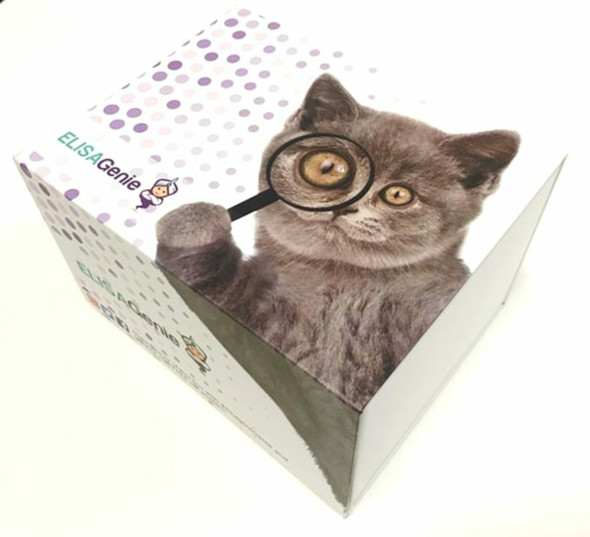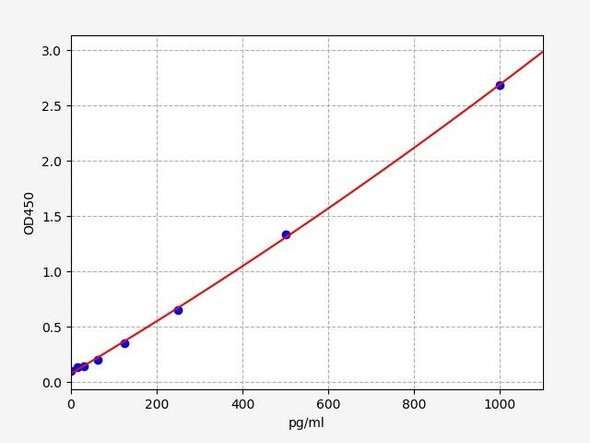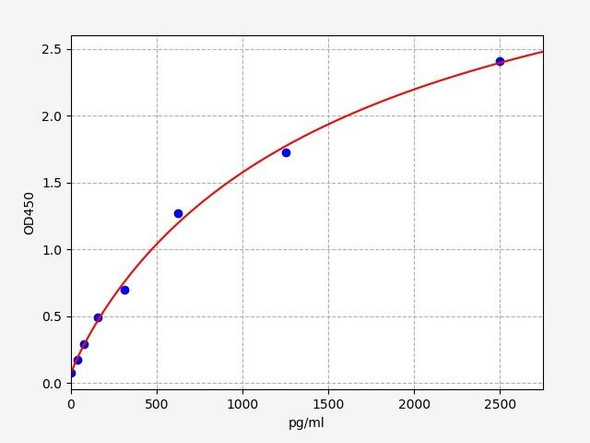Description
Human IL-13ra2 ELISA Kit
The Human IL13RA2 ELISA Kit is specifically designed for the precise measurement of IL13RA2 levels in human serum, plasma, and cell culture supernatants. This kit offers high sensitivity and specificity, ensuring dependable and consistent results, making it ideal for various research applications.IL13RA2, also known as interleukin 13 receptor alpha 2, is a critical protein involved in the immune response and inflammation regulation.
It plays a significant role in conditions such as allergic asthma, inflammatory bowel disease, and multiple sclerosis, making it a valuable biomarker for studying these conditions and potential therapeutic interventions.Overall, the Human IL13RA2 ELISA Kit from Assay Genie is a valuable tool for researchers looking to further understand the role of IL13RA2 in disease pathogenesis and to develop targeted therapies.
| Product Name: | Human IL-13ra2 ELISA Kit |
| SKU: | HUEB0236 |
| Size: | 96T |
| Target: | Human IL-13ra2 |
| Synonyms: | Interleukin-13-binding protein, CD213a2, IL-13 receptor subunit alpha-2, IL13R |
| Assay Type: | Sandwich |
| Detection Method: | ELISA |
| Reactivity: | Human |
| Detection Range: | 0.312-20ng/mL |
| Sensitivity: | 0.1ng/mL |
| Intra CV: | 4.1% | ||||||||||||||||||||
| Inter CV: | 7.3% | ||||||||||||||||||||
| Linearity: |
| ||||||||||||||||||||
| Recovery: |
| ||||||||||||||||||||
| Function: | Binds as a monomer with high affinity to interleukin-13 (IL13), but not to interleukin-4 (IL4). |
| Uniprot: | Q14627 |
| Sample Type: | Serum, plasma, tissue homogenates, cell culture supernates and other biological fluids |
| Specificity: | Natural and recombinant human Interleukin-13 receptor subunit alpha-2 |
| Research Area: | Immunology |
| Subcellular Location: | Membrane Single-pass type I membrane protein |
| Storage: | Please see kit components below for exact storage details |
| Note: | For research use only |
| UniProt Protein Function: | IL13RA2: a type I membrane protein that binds with high affinity to interleukin-13 (IL13), but not to interleukin-4 (IL4). Lacks a cytoplasmic domain, and does not appear to function as a signal mediator. It is reported to play a role in the internalization of IL13. A member of the Cancer-Testis Antigen (CTA) superfamily. CTAs may play roles in embryonal development and tumor transformation or aspects of tumor progression. CTAs were once thought to be silenced in most normal adult tissues, with limited expression in fetal, placental, testis, and ovarian cells. These proteins are now known to be aberrantly expressed in various cancers and many are capable of eliciting humoral and cellular immune responses. The WSXWS motif appears to be necessary for proper protein folding and thereby efficient intracellular transport and cell-surface receptor binding. The box 1 motif is required for JAK interaction and/or activation. Often overexpressed in brain tumors. A potential vaccine targets for immunotherapy of glioma. Note: This description may include information from RefSeq and UniProtKB |
| UniProt Protein Details: | Protein type:Membrane protein, integral; Cancer Testis Antigen (CTA); Receptor, cytokine Chromosomal Location of Human Ortholog: Xq23 Cellular Component: extracellular space; integral to membrane Molecular Function:hematopoietin/interferon-class (D200-domain) cytokine receptor activity; signal transducer activity Biological Process: cytokine and chemokine mediated signaling pathway; signal transduction |
| NCBI Summary: | The protein encoded by this gene is closely related to Il13RA1, a subuint of the interleukin 13 receptor complex. This protein binds IL13 with high affinity, but lacks cytoplasmic domain, and does not appear to function as a signal mediator. It is reported to play a role in the internalization of IL13. [provided by RefSeq, Jul 2008] |
| UniProt Code: | Q14627 |
| NCBI GenInfo Identifier: | 2494720 |
| NCBI Gene ID: | 3598 |
| NCBI Accession: | Q14627.1 |
| UniProt Secondary Accession: | Q14627,O00667, A8K7E2, |
| UniProt Related Accession: | Q14627 |
| Molecular Weight: | 380 |
| NCBI Full Name: | Interleukin-13 receptor subunit alpha-2 |
| NCBI Synonym Full Names: | interleukin 13 receptor, alpha 2 |
| NCBI Official Symbol: | IL13RA2 |
| NCBI Official Synonym Symbols: | CT19; IL-13R; IL13BP; CD213A2 |
| NCBI Protein Information: | interleukin-13 receptor subunit alpha-2; IL-13RA2; IL-13R-alpha-2; IL-13R subunit alpha-2; cancer/testis antigen 19; IL-13 receptor subunit alpha-2; interleukin 13 binding protein; interleukin-13-binding protein; interleukin 13 receptor alpha 2 chain |
| UniProt Protein Name: | Interleukin-13 receptor subunit alpha-2 |
| UniProt Synonym Protein Names: | Interleukin-13-binding protein; CD_antigen: CD213a2 |
| Protein Family: | Interleukin-13 receptor |
| UniProt Gene Name: | IL13RA2 |
| UniProt Entry Name: | I13R2_HUMAN |
| Component | Quantity (96 Assays) | Storage |
| ELISA Microplate (Dismountable) | 8×12 strips | -20°C |
| Lyophilized Standard | 2 | -20°C |
| Sample Diluent | 20ml | -20°C |
| Assay Diluent A | 10mL | -20°C |
| Assay Diluent B | 10mL | -20°C |
| Detection Reagent A | 120µL | -20°C |
| Detection Reagent B | 120µL | -20°C |
| Wash Buffer | 30mL | 4°C |
| Substrate | 10mL | 4°C |
| Stop Solution | 10mL | 4°C |
| Plate Sealer | 5 | - |
Other materials and equipment required:
- Microplate reader with 450 nm wavelength filter
- Multichannel Pipette, Pipette, microcentrifuge tubes and disposable pipette tips
- Incubator
- Deionized or distilled water
- Absorbent paper
- Buffer resevoir
*Note: The below protocol is a sample protocol. Protocols are specific to each batch/lot. For the correct instructions please follow the protocol included in your kit.
Allow all reagents to reach room temperature (Please do not dissolve the reagents at 37°C directly). All the reagents should be mixed thoroughly by gently swirling before pipetting. Avoid foaming. Keep appropriate numbers of strips for 1 experiment and remove extra strips from microtiter plate. Removed strips should be resealed and stored at -20°C until the kits expiry date. Prepare all reagents, working standards and samples as directed in the previous sections. Please predict the concentration before assaying. If values for these are not within the range of the standard curve, users must determine the optimal sample dilutions for their experiments. We recommend running all samples in duplicate.
| Step | |
| 1. | Add Sample: Add 100µL of Standard, Blank, or Sample per well. The blank well is added with Sample diluent. Solutions are added to the bottom of micro ELISA plate well, avoid inside wall touching and foaming as possible. Mix it gently. Cover the plate with sealer we provided. Incubate for 120 minutes at 37°C. |
| 2. | Remove the liquid from each well, don't wash. Add 100µL of Detection Reagent A working solution to each well. Cover with the Plate sealer. Gently tap the plate to ensure thorough mixing. Incubate for 1 hour at 37°C. Note: if Detection Reagent A appears cloudy warm to room temperature until solution is uniform. |
| 3. | Aspirate each well and wash, repeating the process three times. Wash by filling each well with Wash Buffer (approximately 400µL) (a squirt bottle, multi-channel pipette,manifold dispenser or automated washer are needed). Complete removal of liquid at each step is essential. After the last wash, completely remove remaining Wash Buffer by aspirating or decanting. Invert the plate and pat it against thick clean absorbent paper. |
| 4. | Add 100µL of Detection Reagent B working solution to each well. Cover with the Plate sealer. Incubate for 60 minutes at 37°C. |
| 5. | Repeat the wash process for five times as conducted in step 3. |
| 6. | Add 90µL of Substrate Solution to each well. Cover with a new Plate sealer and incubate for 10-20 minutes at 37°C. Protect the plate from light. The reaction time can be shortened or extended according to the actual color change, but this should not exceed more than 30 minutes. When apparent gradient appears in standard wells, user should terminatethe reaction. |
| 7. | Add 50µL of Stop Solution to each well. If color change does not appear uniform, gently tap the plate to ensure thorough mixing. |
| 8. | Determine the optical density (OD value) of each well at once, using a micro-plate reader set to 450 nm. User should open the micro-plate reader in advance, preheat the instrument, and set the testing parameters. |
| 9. | After experiment, store all reagents according to the specified storage temperature respectively until their expiry. |
When carrying out an ELISA assay it is important to prepare your samples in order to achieve the best possible results. Below we have a list of procedures for the preparation of samples for different sample types.
| Sample Type | Protocol |
| Serum | If using serum separator tubes, allow samples to clot for 30 minutes at room temperature. Centrifuge for 10 minutes at 1,000x g. Collect the serum fraction and assay promptly or aliquot and store the samples at -80°C. Avoid multiple freeze-thaw cycles. If serum separator tubes are not being used, allow samples to clot overnight at 2-8°C. Centrifuge for 10 minutes at 1,000x g. Remove serum and assay promptly or aliquot and store the samples at -80°C. Avoid multiple freeze-thaw cycles. |
| Plasma | Collect plasma using EDTA or heparin as an anticoagulant. Centrifuge samples at 4°C for 15 mins at 1000 × g within 30 mins of collection. Collect the plasma fraction and assay promptly or aliquot and store the samples at -80°C. Avoid multiple freeze-thaw cycles. Note: Over haemolysed samples are not suitable for use with this kit. |
| Urine & Cerebrospinal Fluid | Collect the urine (mid-stream) in a sterile container, centrifuge for 20 mins at 2000-3000 rpm. Remove supernatant and assay immediately. If any precipitation is detected, repeat the centrifugation step. A similar protocol can be used for cerebrospinal fluid. |
| Cell culture supernatant | Collect the cell culture media by pipette, followed by centrifugation at 4°C for 20 mins at 1500 rpm. Collect the clear supernatant and assay immediately. |
| Cell lysates | Solubilize cells in lysis buffer and allow to sit on ice for 30 minutes. Centrifuge tubes at 14,000 x g for 5 minutes to remove insoluble material. Aliquot the supernatant into a new tube and discard the remaining whole cell extract. Quantify total protein concentration using a total protein assay. Assay immediately or aliquot and store at ≤ -20 °C. |
| Tissue homogenates | The preparation of tissue homogenates will vary depending upon tissue type. Rinse tissue with 1X PBS to remove excess blood & homogenize in 20ml of 1X PBS (including protease inhibitors) and store overnight at ≤ -20°C. Two freeze-thaw cycles are required to break the cell membranes. To further disrupt the cell membranes you can sonicate the samples. Centrifuge homogenates for 5 mins at 5000xg. Remove the supernatant and assay immediately or aliquot and store at -20°C or -80°C. |
| Tissue lysates | Rinse tissue with PBS, cut into 1-2 mm pieces, and homogenize with a tissue homogenizer in PBS. Add an equal volume of RIPA buffer containing protease inhibitors and lyse tissues at room temperature for 30 minutes with gentle agitation. Centrifuge to remove debris. Quantify total protein concentration using a total protein assay. Assay immediately or aliquot and store at ≤ -20 °C. |
| Breast Milk | Collect milk samples and centrifuge at 10,000 x g for 60 min at 4°C. Aliquot the supernatant and assay. For long term use, store samples at -80°C. Minimize freeze/thaw cycles. |










